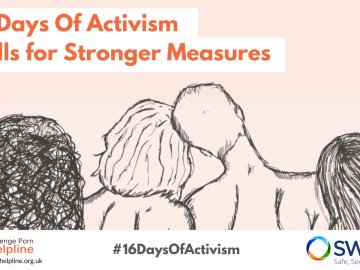The international tide is turning in the fight against image-based abuse. With the recent enactment of the Take It Down Act in the United States and the formal adoption of the UN Cybercrime Convention by the General Assembly, Non-Consensual Intimate Image (NCII) abuse has moved decisively onto the global regulatory agenda. At the heart of these developments is a clear message: platforms must act to prevent the spread of intimate imagery shared without consent, and they must do so at scale.
Hash-matching technology is central to this response. It enables images to be flagged and blocked without needing to store or distribute the content itself. When implemented responsibly, it protects victims' dignity, limits re-traumatisation, and offers a proactive safeguard against further harm. At SWGfL, we believe the question is no longer if platforms should use perceptual hashing to tackle NCII, but how quickly and effectively they can adopt it.
Hash Matching - A Global Solution with Proven Impact
StopNCII.org is the world’s leading privacy-preserving hash-matching tool for NCII prevention. Co-created by SWGfL and a coalition of global partners, the platform empowers individuals to generate hashes (a digital fingerprint) of their intimate content on their own devices, without uploading any imagery. These hashes are then shared securely with participating platforms to prevent known images from being re-shared.
Since its launch, StopNCII has supported thousands of victims and been adopted by some of the most widely used platforms, reaching billions of users. With no equivalent alternative offering the same privacy standards, global reach, and survivor-centred design, StopNCII is increasingly recognised as the default solution for NCII prevention.
Innovation, Collaboration, and Momentum
We are at an incredibly exciting moment for the current state of technology. The pace of innovation in the NCII response space is accelerating, and StopNCII is proud to be driving it forward. This isn’t just about maintaining the status quo; it’s about redefining what’s possible in victim protection, trust, and safety.
StopNCII has built a collaborative approach towards improving protections through new advances in perceptual hash matching, to collaborative use of AI for more accurate detection, our community of partner platforms is actively shaping the next generation of tools to prevent intimate image abuse. These aren’t static integrations, they are dynamic, co-developed, and continually evolving to meet the needs of survivors and moderators alike.
Just as the abuse itself changes through synthetic content, AI-enhanced threats, or coordinated exploitation, so too must the tools we build to fight it. StopNCII is more than a piece of infrastructure; it is a living, responsive ecosystem of technologists, NGOs, and platforms working together to push the boundaries of what's possible in preventing NCII.
Protections Across a Global Scale
Contrary to misconceptions that charities cannot operate at global scale, SWGfL has built a robust infrastructure capable of onboarding and supporting thousands of platforms. The StopNCII system is cloud-based, serverless, and auto-scaling, designed to handle millions of daily API requests without performance degradation.
Automated registration will allow platforms to integrate with minimal delay, and a revised tiered support model ensures that engagement remains efficient and secure. This approach draws on SWGfL’s long-standing delivery of widely used digital platforms supporting tens of thousands of organisations, reinforcing confidence in our ability to support large-scale adoption with stability and reliability. A revised tiered support model will ensure that engagement remains efficient, secure, and scalable to thousands of platforms. Financially, the initiative is underpinned by a sustainable contribution model, with flexibility for hardship and a track record of resilience backed by independent audits with contributions allowing us to maintain and develop StopNCII to stay ahead of the evolving nature of NCII.
Crucially, StopNCII is not operating in isolation. The platform is already connected to a global network of 111 trusted NGO partners across every region of the world, all of whom are actively supporting victims of NCII and gender-based online abuse. This network provides frontline engagement, regional insight, and critical advocacy, all of which reinforce the global architecture behind the platform. It ensures that StopNCII is grounded in lived experience, culturally informed, and responsive to local legal and social contexts.
We are not alone in demonstrating that a not-for-profit model can deliver trusted, technically robust services to industry. NCMEC (the National Center for Missing & Exploited Children) offers a long-standing and widely respected example. As a U.S.-based non-profit, NCMEC operates the CyberTipline and maintains the industry-standard CSAM hash database used globally to protect children online. Their model, independent, privacy-conscious, and rooted in victim protection is an inspiration and validation for initiatives like StopNCII. If it can be done at scale for child protection, it can be done for NCII, too.
Empowering a Global Network
While technical infrastructure is essential, it is the people (survivors, NGOs, and advocates) who make the system powerful. SWGfL is now actively supporting NGOs around the world to engage in verified hash submissions, enabling them to directly support victims while contributing to a broader ecosystem of protection.
Through the development of secure submission portals, shared governance frameworks, and training, these efforts aim to foster a stronger, more coordinated global response to NCII abuse. In practice, this means faster identification of harmful content, greater consistency in takedown processes, and enhanced victim support in regions where national frameworks may still be emerging.
A centralised NCII register (expanded from our UK-based model) would allow trusted organisations to monitor and track takedown efforts, improving transparency and prioritisation. Importantly, this system respects data privacy, avoids duplication, and ensures that platforms respond swiftly to verified content.
The Infastructure Already Exists
The global policy environment is now aligning in a way that demands action. The UN Cybercrime Convention, adopted by the General Assembly in late 2024, includes NCII as a recognised form of technology-facilitated violence, affirming its status as a human rights and criminal justice concern. National responses, such as the Take It Down Act in the United States, place statutory obligations on platforms to adopt technical tools to remove non-consensual sharing of intimate images.
Across the UK, expectations are also rising. In February 2025, Ofcom publicly called on tech companies to make the online world safer for women and girls, highlighting the urgent need for effective platform action on image-based abuse. While the full regulatory landscape is still evolving, it is already clear that platforms are expected to adopt proactive technical measures and hash-matching sits at the centre of those expectations.
In this policy moment, StopNCII stands ready, not just as a tool, but as part of a shared global infrastructure. Our approach combines survivor protection, technical excellence, and international cooperation. For companies navigating compliance, there is no need to build from scratch or wait for future enforcement: the infrastructure already exists, and it is ready to scale.
Join the Global Movement
At SWGfL, we see the future of NCII prevention as multi-layered: survivor-led, technically robust, globally distributed, and locally supported. With StopNCII, we are not only responding to abuse, we are building a system that can prevent it from recurring, across jurisdictions and platforms.
This is a call to action for industry: to join a global movement, to adopt proven tools, and to engage meaningfully with a problem that affects millions. The path to safer digital spaces is clear, and it starts with hash-matching that protects privacy, dignity, and lives.






